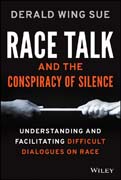
Race Talk and the Conspiracy of Silence: Understanding and Facilitating Difficult Dialogues on Race
Sue, Derald Wing
Learn to talk about race openly, honestly, and productivelyMost people avoid discussion of race–related topics because of the strong emotions and feelings of discomfort that inevitably accompany such conversations. Rather than endure the conflict of racial realities, many people choose instead to avoid the topic altogether, or remain silent when it is raised. Race Talk and the Conspiracy of Silence: Understanding and Facilitating Difficult Dialogues on Race puts an end to that dynamic by sharing strategies for smoothing conversations about race in a productive manner.A guide for facilitating and participating in difficult dialogues about race, author Derald Wing Sue – an internationally recognized expert on multiculturalism, diversity, and microaggressions – explores the characteristics, dynamics, and meaning behind discussions about race as well as the hidden ground rules that inhibit honest and productive dialogue. Through emotional and visceral examples, this book explains why conversations revolving around racial issues are so difficult, and provides guidelines, techniques, and advice for navigating and leading honest and forthright discussions. Readers will develop a stronger ability to build rapport with people unlike themselves, and discover how not talking about race impacts society as a whole.Overcome and make visible the fears associated with race talkLearn practical ideas for talking openly about raceFacilitate and navigate discussion with expert strategyExamine the hidden rules that govern race talkUnderstand the benefits of successful conversationsDiscussions about race do not have to result in disastrous consequences, and can in fact be highly beneficial to all parties involved. It?s important that people have the ability to converse openly and honestly with their students, colleagues, children, and neighbors, and Race Talk provides the path for achieving this goal. INDICE: Preface xi.Acknowledgments xvii.About the Author xix.SECTION ONE: THE CHARACTERISTICS, DYNAMICS, AND MEANING OF RACE TALK.CHAPTER ONE What Is Race Talk? 3.Race Talk Represents a Potential Clash of Racial Realities 7.Race Talk Pushes Emotional Hot Buttons 11.Race Talk Evokes Avoidance Strategies 13.Why Is Successful Race Talk Important? 16.CHAPTER TWO The Characteristics and Dynamics of Race Talk 18.What Are Characteristics of Race Talk? 21.How Do Societal Ground Rules (Norms) Impede Race Talk? 23.Why Is Race Talk So Difficult and Uncomfortable for Participants? 27.Conclusions 33.CHAPTER THREE The Stories We Tell: White Talk Versus Back Talk 35.Race Talk: Narratives and Counter–Narratives 37.Telling on Racism: Unmasking Ugly Secrets 38.SECTION TWO: THE CONSTRAINING GROUND RULES FOR RACE TALK.CHAPTER FOUR The Entire World s a Stage! 55.The Politeness Protocol and Race Talk 57.The Academic Protocol and Race Talk 64.CHAPTER FIVE Color–Blind Means Color–Mute 74.Color–Evasion: We Are All the Same Under the Skin 78.Stereotype–Evasion: I Don t Believe in Those Stereotypes 82.Power–Evasion: Everyone Can Make It in Society, If They Work Hard Enough 86.Myth of the Melting Pot 89.SECTION THREE: WHY IS IT DIFFICULT FOR PEOPLE OF COLOR TO HONESTLY TALK ABOUT RACE?.CHAPTER SIX What Are the Consequences for Saying What I Mean? 95.Ethnocentric Monoculturalism 99.Power and Oppression 105.CHAPTER SEVEN To Speak or How to Speak, That Is the Question 112.Communication Styles 115.Nonverbal Communication 118.Nonverbal Communication in Race Talk: Sociopolitical Considerations 121.Being Constrained and Silenced: Impact on People of Color 123.Conclusions 127.SECTION FOUR: WHY IS IT DIFFICULT FOR WHITE PEOPLE TO HONESTLY TALK ABOUT RACE?.CHAPTER EIGHT I m Not Racist! 131.Cognitive Avoidance Racism Denial 133.Emotional Avoidance Fear, Guilt, and Other Feelings 138.Behavioral Avoidance Helplessness and Hopelessness 142.Emotional Roadblocks to Race Talk 144.CHAPTER NINE I m Not White; I m Italian! 147.What Does It Mean to Be White? 148.The Invisibility of Whiteness: What Does It Mean? 152.The Fear of Owning White Privilege 154.Fear of Taking Personal Responsibility to End Racism: Moving From Being Nonracist to Becoming Antiracist 159.SECTION FIVE: RACE TALK AND SPECIAL GROUP CONSIDERATIONS.CHAPTER TEN Interracial/Interethnic Race Talk: Difficult Dialogues Between Groups of Color 167.Interracial/Interethnic Relationship Issues 169.Race Talk: Fears of Divide and Conquer 171.Sources of Conflict Between People of Color 174.CHAPTER ELEVEN Race Talk and White Racial Identity Development: For Whites Only 186.Developing a Nonracist and Antiracist Racial Identity 189.White Racial Identity Development and Race Talk 202.SECTION SIX: GUIDELINES, CONDITIONS, AND SOLUTIONS FOR HAVING HONEST RACIAL DIALOGUES.CHAPTER TWELVE Being an Agent of Change: Guidelines for Educators, Parents, and Trainers 209.Talking to Children About Race and Racism 213.Guidelines for Taking Personal Responsibility for Change 214.CHAPTER THIRTEEN Helping People Talk About Race: Facilitation Skills for Educators and Trainers 226.Ineffective Strategies: Five Things Not to Do 230.Successful Strategies: Eleven Potentially Positive Actions 234.References 245.Author Index 261.Subject Index 267
- ISBN: 978-1-118-95872-8
- Editorial: John Wiley & Sons
- Encuadernacion: Cartoné
- Páginas: 304
- Fecha Publicación: 11/02/2015
- Nº Volúmenes: 1
- Idioma: Inglés
